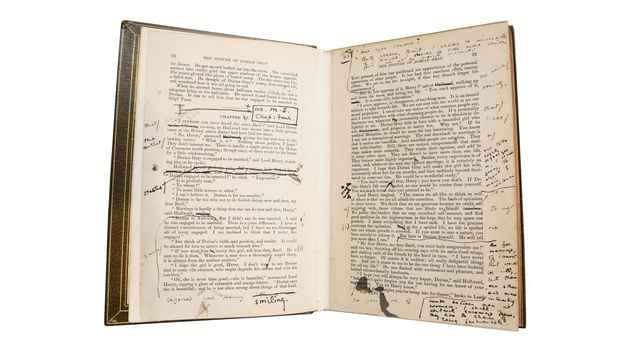“On the Edge of Visibility: Lessons in Transgression” Exhibition
Shin Gallery (66-68 Orchard St.)

[Image: Oscar Wilde Two leaves, pp 31-34, from The Picture of Dorian Gray 1891 paper]
This event has ended.
This queer art-historically poised exhibition treks through artists who, trading before, and then along, the linguistic categories that apply to sexuality outside of the heterosexual stricture, bring desire to the fore. The exhibition culminates in the mid-nineteenth century, when the term “homosexual” was coined in Europe and thus the “first homosexuals” were baptized. Yet works from centuries prior increasingly illuminate a heterodox condition—seductive images that hint at and whisper at homosexuality, ways of being that were pre-linguistically determined but nevertheless extant, vibrant, and teeming. Sweeping admiration of the male, female, or intersex form in figure studies emphasize musculature; exultation and exaltation, adulation and adoration—fixation on the tensing of a forearm or the flicker of light against a half-sunken drunken eyelid. These are subtle themes that, at times, abound with “queering”, a notoriously thorny concept. Elsewhere, man is raised to the status of Greek gods and the Epicurean pools and seeps, a deluge of libertinage: erotic and orgiastic scenes multiply, phalluses wrapped around each other like spindly serpents, prodding into orifices like fingers against honey. What is “queer” here erupts beyond the frame, transfixing us into a way of looking, feeling, admiring and a somatic, affective becoming of arousal.
None of this is to romanticize an antediluvian epoch of same-sex desire catalyzed by clandestine grins and alley-way cruising bereft of censure. Such celebrations were always met with rebuke if not outright discipline, long before the introduction of the term “homosexual”. But the introduction of the linguistic concept in the nineteenth century did animate a critical shift in the Overton window of art, jurisprudence, and being. For as Robert Brandom, writing on pragmatist semantics, has noted, introducing new terms that reference a concept beyond those contained in an antecedent vocabulary has the effect of framing new descriptions of situations and allows language-bearers to make novel claims about the world. This, in turn, makes us capable of forming new intentions, arming us to be able to perform an indefinite number of novel actions, directed at ends that we could not previously have had. That is, both our intentional and representational capacities are of a piece with our linguistic arsenal. Hence, this exhibition illuminates how, in conjunction with the introduction of the term “homosexual” and, subsequently, “transexual”, epochal understandings, conceptions, and representations of queer desire also evolved.
Particular epochs of interest include Weimar Germany, where Magnus Hirschfeld’s Institut für Sexualwissenschaft birthed novel clinical research on gender identities and sexuality, and the so-called “aesthetic movement” in fin-de-siècle England. Lili Elbe’s self-conception, as narrated in one of the first ever works of autofiction, “Fra Mand til Kvinde: Lili Elbes Bekendelser” (1931), is a citadel of the former. The latter, fathered by Oscar Wilde on the literary side and sporting Whistler and Beardsley, amongst others, as compatriots, brought about a conscious departure from essentialist understandings of sexual identity. Many have theorized the “aesthetic movement”, in its voluptuous indolence, as akin to “queer theory before queer theory”. The same languid vapor is gleaned in Wilhelm von Gloeden’s Taormina photo-studies.
The works herewith do not necessarily all deal with figurative same-sex or queer desire; to do so would be reductive and elide the genuinely transgressive nature of trans-categorial experimentation, which so often has marked queer art history the likes of Carrie Moyer, Edie Fake, Math Bass, and Jade Yumang, amongst others. Nor are all the artists necessarily queer, themselves—artists like Hokusai captured the gay quarter in Senju, presenting a queer geography, stilting a moment in time. Just as the linguistic introduction of the term “homosexual” unraveled a coeval transgression in self-conception, the works here comprehensively relay myriad modes of transgression (in style, medium, and painterly praxis). In turn, the exhibition also resists a recent trend amongst curators to exclusively celebrate the biographical exhibition-value of queer artists, belying the radical lessons in aesthetics proffered by thinkers as diverse as Leon Trotsky, Harold Rosenthal, and Arthur Danto: art’s autonomy from outside constraints (viz., “art for art’s sake”). This is not a showing of activist aesthetics. Neither insisting on a commonality captured by the queer artists of history nor underscoring the biographical exhibition-value of the queer artists at hand, we turn to instances of transgression, heeding Mike White’s call to “make homosexuality transgressive again”. For, indeed, homosexuality has a most interesting and valuable story to tell us about transgression. In turn, this exhibition elaborates the transgressive kernel spurring queer art history in variegated directions.
Media
Schedule
from February 14, 2023 to March 18, 2023
Opening Reception on 2023-02-14 from 17:30 to 19:30